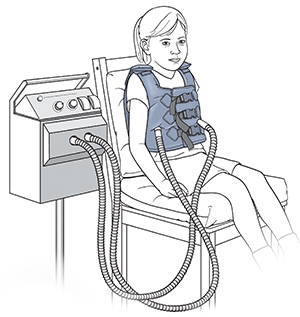Lung Health for a Child with Cystic Fibrosis
Lung Health for a Child with Cystic Fibrosis
If your child has cystic fibrosis, you need to work closely with your child’s doctor and the rest of his or her healthcare team. This helps your child to stay healthier, feel better, and have a better quality of life. It also slows the decline in your child’s lung function. Your child’s doctor may suggest many ways to maintain lung health. These include chest physical therapy (CPT), medicine, nutrition, and exercise.
Chest physical therapy (CPT)
Chest physical therapy helps loosen and clear thick secretions from the lungs. It greatly improves lung function and reduces the amount of lung damage over time. You will work with a physical therapist to learn how to do CPT. CPT usually includes 3 techniques:
Postural drainage involves placing your child’s body in positions that allow mucus to drain.
Percussion is a clapping technique to loosen secretions. An airway clearance device, such as a vibrating vest, is an alternative to manual clapping.
Coughing is used to help remove lung secretions.
A vibrating vest is an airway clearance device that helps loosen mucus. |
A nebulizer turns medication into a fine mist that your child can breathe in. |
Medication
Your child may need medication to prevent or treat lung problems. Many are taken with a nebulizer. This is a device that turns medicine into a mist that your child can inhale. Medicines can include:
Oral, inhaled, or IV (intravenous) antibiotics to prevent or treat lung infections.
Bronchodilators to help open airways.
Anti-inflammatory medicines to decrease airway inflammation.
Medicines, such as dornase alpha or hypertonic saline, to thin secretions.
Nutrition
Improving your child’s nutrition can also improve lung health. It does this by limiting infections. It also helps with other problems related to cystic fibrosis. You will work with your child’s healthcare team to do one or more of the following:
Increase the number of calories your child eats.
If recommended by the doctor, give your child more foods high in antioxidants (chemicals that reduce damage from inflammation in the body).
Give your child prescribed pancreatic enzymes to help with nutrient absorption.
Give your child recommended vitamin supplements to replace those not well absorbed from food.
Exercise
Encourage your child to be active. Exercise helps your child stay healthier. It improves your child’s overall condition and helps him or her feel better. It also helps to loosen mucus, which makes it easier to breathe.
Follow-up care
Your child should see a doctor who is trained in treating cystic fibrosis every 3 months. If a cold or other breathing problem develops, you may need to visit the doctor more often. Your child can see his or her regular healthcare provider for minor problems not related to cystic fibrosis.
When to seek medical care
Call the doctor right away if your child has any of the following:
Increased cough or amount of sputum
Wheezing or shortness of breath
Decreased appetite
Fever of 100.4°F (38.0°C) or higher
Chest pain or tightness
Abdominal pain
Updated:
March 30, 2018
Sources:
Cystic fibrosis: Overview of the treatment of lung disease, Up To Date
Reviewed By:
Blaivas, Allen J., DO,Dozier, Tennille, RN, BSN, RDMS,Images reviewed by StayWell art team.

